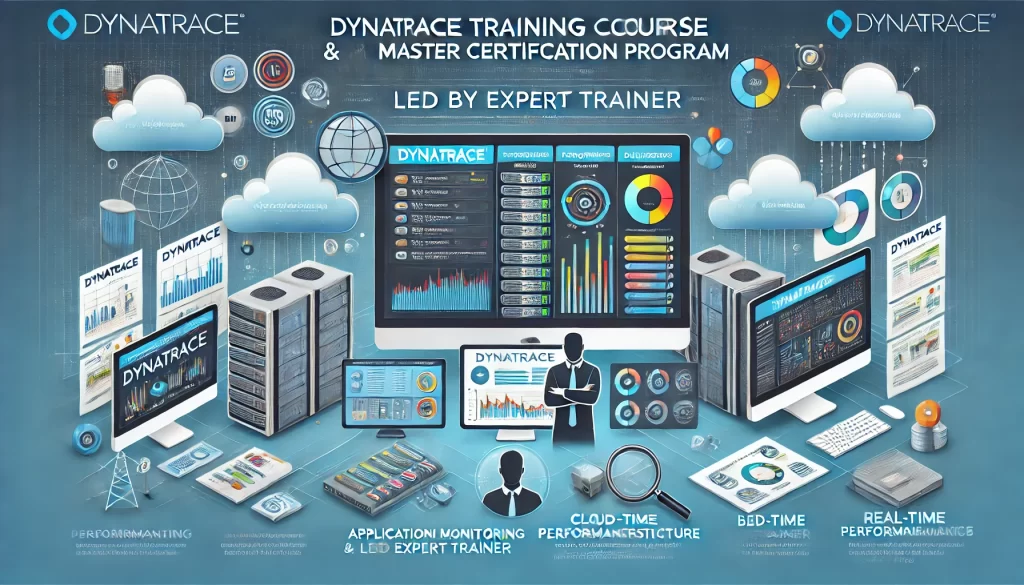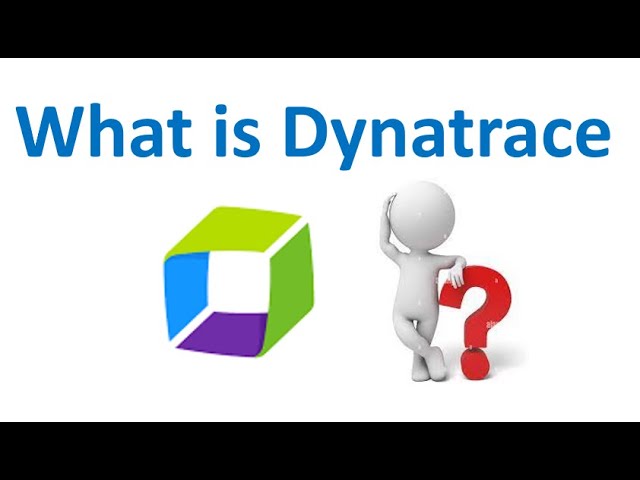
The Dynatrace Training Course & Master Certification Program by theaiops.com is a comprehensive course crafted for IT professionals, DevOps teams, and application developers who want to master Dynatrace, an advanced AI-powered observability platform. Led by expert trainer Rajesh Kumar from RajeshKumar.xyz, this program covers the essentials of Dynatrace, including application and infrastructure monitoring, automated root cause analysis, user experience tracking, and cloud automation. Through hands-on labs and real-world scenarios, participants learn to set up Dynatrace for real-time performance monitoring, troubleshoot application issues, and gain deep visibility into system health. The course also prepares learners for the Dynatrace Master Certification, validating their expertise and positioning them as proficient users of this powerful platform. By the end of the program, professionals are empowered to leverage Dynatrace to enhance operational efficiency, ensure application reliability, and deliver exceptional digital experiences.
What is Dynatrace?

Dynatrace is an AI-powered observability platform designed to provide comprehensive visibility and control over modern, dynamic, multi-cloud environments. Used widely by DevOps, IT operations, and application teams, Dynatrace offers real-time monitoring across applications, infrastructure, and user experiences, utilizing AI to automate root cause analysis and detect performance anomalies. With features like application performance monitoring (APM), infrastructure monitoring, digital experience monitoring, and cloud automation, Dynatrace helps organizations troubleshoot issues faster, optimize resource utilization, and ensure reliable digital experiences. Its powerful AI-driven insights streamline problem-solving by pinpointing the exact causes of issues, reducing downtime, and improving operational efficiency. By unifying observability data on a single platform, Dynatrace enables organizations to manage complex systems more effectively, enhancing service delivery and accelerating digital transformation.
Why Dynatrace is Important
With the rapid shift toward cloud-native and microservices architectures, maintaining performance and reliability in complex environments is increasingly challenging. Dynatrace is an essential tool for addressing these challenges for several reasons:
- Comprehensive Observability: Dynatrace provides full-stack monitoring across applications, infrastructure, and user experiences, allowing teams to understand the entire system’s health and performance at a glance.
- AI-Driven Insights and Automation: Dynatrace’s AI, Davis, automates anomaly detection, alerting, and root cause analysis, reducing the manual work required to identify and resolve issues.
- Proactive Issue Resolution: With real-time alerts and AI-driven insights, Dynatrace allows teams to identify and resolve issues before they impact users, resulting in improved reliability and user satisfaction.
- Support for Modern Architectures: As more organizations adopt microservices and cloud-native environments, Dynatrace’s distributed tracing, Kubernetes monitoring, and cloud integrations provide the visibility needed to manage these environments effectively.
- Enhanced User Experiences: By tracking real user interactions through Digital Experience Monitoring (DEM), Dynatrace helps teams identify and eliminate friction points, improving application usability and customer satisfaction.
- Scalability and Flexibility: Dynatrace is designed to scale with organizations, providing robust monitoring for everything from small applications to enterprise-scale infrastructures, making it suitable for businesses of all sizes.
- Data-Driven Decision Making: Dynatrace’s metrics, dashboards, and AI-powered insights enable teams to make informed decisions, prioritize resources, and optimize performance based on real data.
Course Features
This comprehensive Dynatrace training course is designed to provide an engaging, hands-on experience that prepares participants to implement Dynatrace in real-world scenarios. Course highlights include:
- Complete Curriculum on Dynatrace Features: Covers all essential aspects of Dynatrace, including APM, infrastructure monitoring, DEM, distributed tracing, log analytics, and AI-driven observability.
- Hands-On Labs with Real-World Use Cases: Each module includes practical exercises where participants will set up Dynatrace agents, create dashboards, configure alerts, and troubleshoot applications, helping them build hands-on skills.
- Case Studies and Industry-Specific Examples: Participants will work through examples and scenarios based on real-world applications, including monitoring for e-commerce, optimizing cloud environments, and improving customer experience.
- Lifetime Access to Course Materials: Participants have access to all recorded sessions, guides, and resources for future reference, allowing them to revisit and deepen their knowledge as they continue to work with Dynatrace.
- Led by Industry Expert Rajesh Kumar: The course is conducted by Rajesh Kumar, a seasoned Dynatrace practitioner with extensive experience in observability, monitoring, and performance optimization, ensuring participants receive guidance from a knowledgeable trainer.
Training Objectives
This course is designed to ensure participants gain a comprehensive understanding of Dynatrace’s capabilities and can apply their skills in any professional setting. By the end of the course, participants will be able to:
- Set Up Dynatrace Environments: Deploy and configure Dynatrace agents on different infrastructure components, including cloud, containers, and virtual machines.
- Monitor Application Performance: Use Dynatrace’s APM tools to monitor application health, identify bottlenecks, and improve application reliability.
- Track and Analyze User Experiences: Implement Digital Experience Monitoring (DEM) to track real user interactions, identify pain points, and optimize applications for better user experiences.
- Leverage Distributed Tracing for Microservices: Use distributed tracing to monitor complex service interactions and dependencies, improving visibility into microservices architectures.
- Automate Problem Detection and Resolution: Use Dynatrace’s AI-driven insights to automate the detection of anomalies, root cause analysis, and alerting for proactive performance management.
- Perform Log Monitoring and Analysis: Aggregate, search, and analyze log data to gain insights into issues, troubleshoot performance problems, and correlate logs with other metrics.
- Optimize Cloud and Kubernetes Environments: Monitor Kubernetes clusters, orchestrated workloads, and cloud resources to ensure optimal performance, scalability, and resource utilization.
Target Audience
This course is ideal for IT professionals, developers, and engineers looking to advance their monitoring and observability skills with Dynatrace:
- System Administrators and IT Operations Teams: Responsible for maintaining infrastructure health, uptime, and reliability across environments.
- Application Developers and Performance Engineers: Developers focused on application optimization, troubleshooting, and improving end-user experience.
- DevOps Engineers and Cloud Architects: Engineers working in CI/CD environments who want to integrate monitoring and observability into their DevOps pipelines.
- Cloud and Kubernetes Engineers: Professionals managing cloud-native and containerized applications who need visibility into distributed systems and orchestration layers.
- Security Analysts and Incident Responders: Individuals looking to enhance security monitoring through Dynatrace’s anomaly detection and AI-driven insights.
Training Methodology
This Dynatrace course employs a structured approach, combining lectures, hands-on labs, and project-based assignments to provide a balanced learning experience:
- Lecture-Based Theoretical Sessions: Each module includes a lecture that covers essential Dynatrace concepts, ensuring participants understand the “why” and “how” of each tool and feature.
- Hands-On Labs for Skill Application: Labs are designed to reinforce learning, with exercises that allow participants to set up Dynatrace, create dashboards, configure alerts, and troubleshoot applications in real-time.
- Project-Based Assignments and Real-World Scenarios: Participants will apply their skills through assignments that simulate real-world scenarios, such as optimizing a cloud application, monitoring a microservices environment, and troubleshooting performance issues.
- Interactive Q&A and Peer Discussions: Opportunities for questions and collaborative discussions enable participants to share knowledge, clarify doubts, and learn from each other’s experiences.
- Regular Assessments and Feedback: Quizzes and assignments after each module help reinforce learning, gauge comprehension, and ensure participants are ready to implement Dynatrace professionally.
Certification Program
Upon course completion, participants will receive a certification from DevOpsSchool.com, demonstrating their expertise in Dynatrace’s observability and monitoring tools:
- Industry-Recognized Certification: This certification verifies participants’ proficiency in Dynatrace, covering setup, configuration, monitoring, alerting, and troubleshooting.
- Digital Badge for Professional Profiles: Participants receive a digital badge for LinkedIn, resumes, and portfolios to showcase their skills to potential employers.
- Lifetime Access to Certification Resources: Certified participants retain access to course resources, supporting continuous learning and skills advancement as Dynatrace evolves.
Agenda of Dynatrace Training Program
Day 1: Introduction to Dynatrace and Application Performance Monitoring
- Overview of Dynatrace: Understand Dynatrace’s core features, architecture, and AI-driven approach.
- Setting Up Dynatrace: Install Dynatrace agents, configure initial settings, and explore the Dynatrace user interface.
- Application Performance Monitoring (APM): Learn to track application health, diagnose issues, and use transaction tracing for deeper insights.
- Hands-On Lab: Setting up Dynatrace APM, configuring monitoring, and creating a dashboard to visualize key application metrics.
Day 2: Infrastructure Monitoring, Alerts, and Distributed Tracing
- Infrastructure Monitoring: Configure monitoring for servers, cloud resources, containers, and virtual machines.
- Setting Up Alerts and Proactive Notifications: Define alert thresholds, set up notifications, and configure incident management workflows.
- Distributed Tracing and Service Mapping: Learn how to trace requests across microservices and understand dependencies between services.
- Hands-On Lab: Setting up infrastructure monitoring, configuring alerts, and enabling distributed tracing to monitor a sample microservices application.
Day 3: Digital Experience Monitoring, Log Monitoring, and AI-Powered Observability
- Digital Experience Monitoring (DEM): Capture user interactions, analyze session data, and optimize user experiences.
- Log Monitoring and Analytics: Aggregate and analyze log data, correlating it with metrics to troubleshoot and resolve issues.
- AI-Driven Observability (Davis AI): Use Davis AI for anomaly detection, automated root cause analysis, and proactive incident management.
- Hands-On Lab: Implementing DEM, configuring log monitoring, and using Davis AI to detect anomalies and troubleshoot performance issues in real-time.
Lab Setup
To support hands-on learning, participants will set up a dedicated lab environment for Dynatrace, including:
- Required Software: Dynatrace agents, sample applications, and access to cloud resources or local servers for monitoring.
- Hardware Requirements: A laptop or desktop with a minimum of 8GB RAM, multi-core processor, and stable internet connection.
- Cloud or Local Deployment Options: Labs can be configured on cloud platforms like AWS, Azure, or GCP, or set up locally depending on participant preference.
- Step-by-Step Setup Guide: A detailed setup guide ensures participants are fully prepared for labs and exercises, providing an immersive learning experience.
Trainers
The course is led by Rajesh Kumar, a recognized expert in monitoring, observability, and performance engineering. Rajesh brings years of practical experience in deploying Dynatrace solutions for diverse environments, providing participants with actionable insights and practical skills to succeed in their roles.
Frequently Asked Questions (FAQ)
- Who should attend this Dynatrace course?
- This course is ideal for system administrators, DevOps engineers, cloud architects, application developers, and IT managers.
- Is prior experience with Dynatrace required?
- No prior Dynatrace experience is necessary, though a basic understanding of monitoring and observability concepts is beneficial.
- Will I get hands-on practice?
- Yes, each module includes hands-on labs where participants set up and configure Dynatrace components.
- What makes Dynatrace unique compared to other tools?
- Dynatrace offers AI-driven anomaly detection, automated root cause analysis, and end-to-end observability, making it one of the most comprehensive observability platforms available.
- What applications can Dynatrace monitor?
- Dynatrace can monitor a wide range of applications, including web applications, mobile apps, microservices, cloud environments, and on-premises infrastructure.
- Will I receive certification?
- Yes, participants receive a DevOpsSchool.com certification upon successful completion of the course.
- How customizable are Dynatrace dashboards?
- Dynatrace dashboards are highly customizable, allowing users to create layouts tailored to specific metrics and needs.
- What is Davis AI, and how does it work?
- Davis AI is Dynatrace’s artificial intelligence engine that automates anomaly detection and root cause analysis, providing proactive insights and recommendations.
- Does Dynatrace support multi-cloud environments?
- Yes, Dynatrace integrates with AWS, Azure, GCP, and other cloud providers, making it ideal for multi-cloud observability.
- How does Dynatrace handle log monitoring?
- Dynatrace aggregates log data and correlates it with performance metrics, enabling faster root cause analysis.
- Can Dynatrace monitor user experience?
- Yes, Dynatrace’s Digital Experience Monitoring (DEM) captures real user interactions, tracking performance and improving user satisfaction.
- What level of automation does Dynatrace offer?
- Dynatrace provides extensive automation, from issue detection to alerting and root cause analysis, helping teams save time.
- Does the course cover Dynatrace setup for Kubernetes?
- Yes, the course includes Kubernetes monitoring and configuration for containerized environments.
- What industries benefit from Dynatrace?
- Dynatrace is widely used across e-commerce, finance, healthcare, technology, and other sectors needing observability.
- Is there post-course support?
- Yes, participants have ongoing access to resources and community support for further learning.
